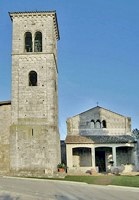


According to local tradition, this was the site of a Roman villa that belonged to Lucius Julius Marcianus (a duoviro of splenddissima colonia Tuder, i.e. Todi), probably because he and his wife Publica feature in the inscriptions (respectively CIL XI 4659 and 4660) embedded to the right of the trifore window in the facade:
L(ucio) Iulio L(uci) f(ilio) / Clu(stumina) Marcia/no
aed(ili) IIvir/o omnibus hono/ribus in splendi/dissima coloni[a] / Tuder
probe / functo ob me/rita eius cives posuerunt
Publiciae / L(uci) f[i](l)[i]a[e] Hone/stae matron(a)e
castissim(a)e et car(a)e / coniugi Iuli Marci / ani(ensi)
ob merita ma/riti cives ex aere / collato l(ocus) d(atus) d(ecreto) d(ecurionum)
[Recent excavations have revealed the foundations of the Roman villa??] [A judge called Marcianus appears in the legend of St Brictius, Bishop of Civitas Martana].
A community of Benedictines drained the land and built an abbey here, near the Christian catacombs and the burial place of St Faustinus using remains from the Roman villa. Surviving architectural fragments (including a number of capitals) suggest that this first church was built in the 9th century.
San Faustino was subordinated to the Abbazia di Farfa in 1104, an arrangement that the Emperor Henry V confirmed in 1118.
The church was converted into a collegiate church for the secular clergy in the 17th century.
The ex-monastery has been adapted for residential use.
Exterior
A porch that was added in 1956 spoils the 13th century façade, although the three-light window and Doric frieze from a much older building survive.
The modern campanile blends well with the 13th century architecture.
Interior
The interior has been remodelled. It originally had a raised presbytery above a crypt. However, the crypt was filled in in the 18th century and the pavement was levelled.
Two sarcophagi were moved from the crypt and used to form the high altar. This was demolished in 1948, at which point one of them was found to contain the relics of St Faustinus, identified by an inscription.




